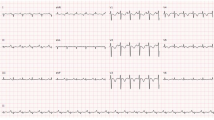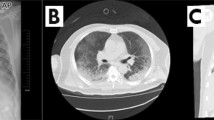Abstract
Although parvovirus B19 (PVB19) currently is the most common cause of viral myocarditis, limited pediatric data exist. Whereas other viruses infect cardiomyocytes, PVB19 targets coronary endothelium, leading to myocardial ischemia and dysfunction. A retrospective review investigated patients with polymerase chain reaction (PCR)-verified PVB19 myocarditis at Texas Children’s Hospital and Arkansas Children’s Hospital (January 2005 to August 2008). The primary end points of the study were transplant-free survival and circulatory collapse (death, mechanical support, or transplantation). For the 19 patients identified (age, 6 months to 15 years), the most common presenting symptoms were respiratory and gastrointestinal. At admission, all the patients demonstrated ventricular dysfunction requiring inotropic support (median ejection fraction, 24 %; median left ventricle end-diastolic diameter [LVEDD] z-score, 4.6). Whereas T-wave abnormalities were common, ST elevation was evident in five patients (two died and three required transplantation). Serum B-type natrietic peptide was elevated in all 12 patients tested (range, 348–8,058 pg/ml), and troponin I was high in 7 of 9 patients (range, 0.04–14.5 ng/ml). Of the 15 patients with circulatory collapse, nine received mechanical support, eight underwent successful transplantation, and five died. Only six patients (32 %) experienced transplant-free survival, and five patients had full recovery of function at discharge. In the transplant-free survival group, ST changes on presenting electrocardiography were less likely (p = 0.03), and the admission LVEDD z-score tended to be lower (3.3 vs 5.6; p = 0.08). In children, PVB19 myocarditis causes significant mortality and morbidity. Although mechanical intervention can support patients in the initial stage of decompensated heart failure, patients with PVB19 myocarditis often demonstrate persistent dysfunction requiring medical therapy and transplantation.


Similar content being viewed by others
References
Amabile N, Fraisse A, Bouvenot J, Chetaille P, Ovaert C (2006) Outcome of acute fulminant myocarditis in children. Heart 92:1269–1273
Bock CT, Klingel K, Aberle S, Duechting A, Lupescu A, Lang F, Kandolf R (2005) Human parvovirus B19: a new emerging pathogen of inflammatory cardiomyopathy. J Vet Med B 52:340–343
Bultmann BD, Klingel K, Sotlar K, Bock CT, Baba HA, Sauter M, Kandolf R (2003) Fatal parvovirus B19- associated myocarditis clinically mimicking ischemic heart disease: an endothelial cell-mediated disease. Hum Pathol 34:92–95
Cooper LT (2009) Myocarditis. N Engl J Med 360:1526–1538
Dina J, Villedieu F, Labombarda F et al (2011) Childhood myocarditis and parvovirus B19 genotypes. J Clin Virol 50:61–64
Duncan BW, Bohn DJ, Atz AM, French JW, Laussen PC, Wessel DL (2001) Mechanical circulatory support for the treatment of children with acute fulminant myocarditis. J Thorac Cardiovasc Surg 122:440–448
Feldman AM, McNamara D (2000) Myocarditis. N Engl J Med 343:1388–1398
Kindermann I, Kindermann M, Kandolf R, Klingel K, Bultmann B, Muller T, Lindinger A, Bohm M (2008) Predictors of outcome in patients with suspected myocarditis. Circulation 118:639–648
Koehl B, Oualha M, et al (2012) Fatal parvovirus B19 myocarditis in children and possible dysimmune mechanism. Pediatr Infect Dis J 31(4):418–421
Kuhl U, Pauschinger M, Bock CT, Klingel K, Schwimmbeck CP, Seeberg B, Krautwurm L, Poller W, Schultheiss HP, Kandolf R (2003) Parvovirus B19 infection mimicking acute myocardial infarction. Circulation 108:945–950
Kuhl U, Pauschinger M, Seeberg B, Lassner D, Noutsias M, Poller W, Schultheiss HP (2005) Viral persistence in the myocardium is associated with progressive cardiac dysfunction. Circulation 112:1965–1970
Kuhl U, Pauschinger M, Noutsias M, Seeberg B, Bock CT, Lassner D, Poller W, Kandolf R, Schultheiss HP (2005) High prevalence of viral genomes and multiple viral infections in the myocardium of adults with “idiopathic” left ventricular dysfunction. Circulation 111:887–893
Mahrholdt H, Wagner A, Deluigi CC, Kispert E, Hager S, Meinhardt G, Vogelsberg H, Fritz P, Dippon J, Bock CT, Klingel K, Kandolf R, Sechtem U (2006) Presentation, patterns of myocardial damage, and clinical course of viral myocarditis. Circulation 114:1581–1590
McCarthy RE, Boehmer JP, Hruban RH, Hutchins GM, Kasper EK, Hare JM, Baughman KL (2000) Long-term outcome of fulminant myocarditis as compared with acute (nonfulminant) myocarditis. N Engl J Med 342:690–695
Mlczoch E, Darbandi-Mesri F, Luckner D, Salzer-Muhar U (2012) NT-pro BNP in acute childhood myocarditis. J Pediatr 160:178–179
Murry CE, Jerome KR, Reichenbach DD (2001) Fatal parvovirus myocarditis in a 5-year-old girl. Hum Pathol 32(3):342–345
Nigro G, Bastianon V, Colloridi V, Ventriglia F, Gallo P, D’Amati G, Koch WC, Adler SP (2000) Human parvovirus B19 infection in infancy associated with acute and chronic lymphocytic myocarditis and high cytokine levels: report of 3 cases and review. Clin Infect Dis 31:65–69
Ogawa T, Veinot JP, Kuroski de Bold ML et al (2008) Angiotensin II receptor antagonism reverts the selective cardiac BNP upregulation and secretion observed in myocarditis. Am J Physiol Heart Circ Physiol 24:1046–1054
Pankuweit S, Ruppert V, Eckhardt H, Strache D, Maisch B (2005) Pathophysiology and aetiological diagnosis of inflammatory myocardial diseases with a special focus on parvovirus B19. J Vet Med B Infect Dis Vet Public Health 52:344–347
Papadogiannakis N, Tolfvenstam T, Fischler B, Norbeck O, Broliden K (2002) Active, fulminant, lethal myocarditis associated with parvovirus B19 infection in an infant. Clin Infect Dis 35:1027–1031
Rohayem J, Dinger J, Fischer R, Klingel K, Kandolf R, Rethwilm A (2001) Fatal myocarditis associated with acute parvovirus B19 and human herpesvirus 6 co-infection. J Clin Microbiol 4585–4587
Saint-Martin J, Chonlot JJ, Bonnaud E, Monnet F (1990) Myocarditis caused by parvovirus. J Pediatr 116:1007–1008
Schowengerdt KO, Ni J, Denfield S, Gajarski RJ, Bowles NE, Rosenthal G, Kearney D, Price JK, Rogers BB, Schauer GM, Chinnock RE, Towbin JA (1997) Association of parvovirus B19 genome in children with myocarditis and cardiac allograft rejection. Circulation 96:3549–3554
Servant A, Laperche S, Lallemand F et al (2002) Genetic diversity within human erythroviruses: identification of three genotypes. J Virol 76:9124–9134
Teele SA, Allan CK, Laussen PC et al (2011) Management and outcomes in pediatric patients presenting with acute fulminant myocarditis. J Pediatr 158:638–643
Tschope C, Bock CT, Kasner M, Noutsias M, Westermann D, Schwimmbeck PL, Pauschinger M, Poller WC, Kuhl U, Kandolf R, Schultheiss HP (2005) High prevalence of cardiac parvovirus B19 infection in patients with isolated left ventricular diastolic dysfunction. Circulation 111:879–886
Von Kaisenberg CS, Bender G, Scheewe J, Hirt SW, Lange M, Stieh J, Kramer HH, Jonat W (2001) A case of fetal parvovirus B19 myocarditis, terminal cardiac heart failure, and perinatal heart transplantation. Fetal Diagn Ther 16(6)
Young NS, Brown KE (2004) Parvovirus B19. N Engl J Med 350:586–597
Author information
Authors and Affiliations
Corresponding author
Rights and permissions
About this article
Cite this article
Molina, K.M., Garcia, X., Denfield, S.W. et al. Parvovirus B19 Myocarditis Causes Significant Morbidity and Mortality in Children. Pediatr Cardiol 34, 390–397 (2013). https://doi.org/10.1007/s00246-012-0468-4
Received:
Accepted:
Published:
Issue Date:
DOI: https://doi.org/10.1007/s00246-012-0468-4




